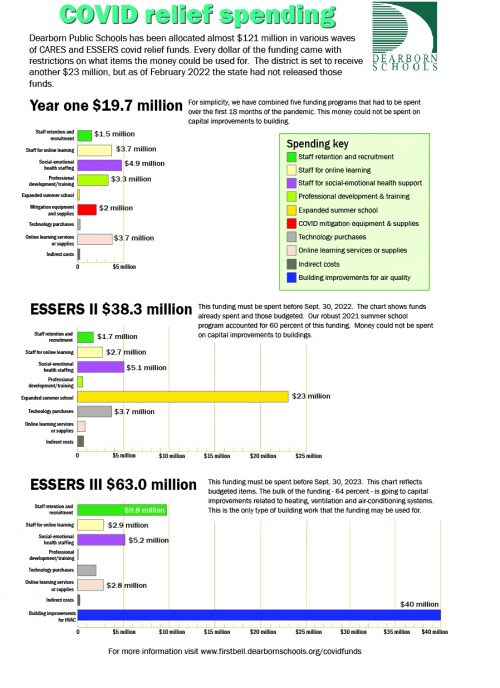Press Release #34/Feb. 16, 2022
Interested in how Dearborn Public Schools has spent millions of dollars in COVID relief funding?
Dearborn Public Schools has created a new webpage at https://firstbell.dearbornschools.org/covidfunds with information about how the various waves of funding have been spent or are budgeted to be spent. The page will continue to be updated.
So far, the district has been allocated $121 million in federal funding through several waves of programs, generally called Elementary and Secondary School Emergency Relief funds (ESSER). The district expects to receive another $23 million, but the state has not yet released those funds.
Every dollar of ESSER and COVID relief funding came with restrictions about how the district is allowed to spend that money. Funding is more or less restricted to items related to the pandemic. It was not until the ESSER III funding that schools were allowed to spend any money on building improvements. Even then, any building improvements were limited to certain heating, ventilation, and air-conditioning (HVAC) work since improving air ventilation helps reduce the risk of germs spreading inside buildings. Any other capital improvements, such as roofs, parking lots, lighting, buses and floors, could not be funded with ESSER dollars
Of the $63 million the district is currently allowed to spend in ESSER III funding, $40 million has been budgeted for HVAC work in the buildings. That amount accounts for 64 percent of that wave of funding and 33 percent of total ESSER money the district has received or budgeted so far.
The next largest item was $23 million spent on the 2021 summer school program. About 8,400 students participated in the free, hands-on educational and enrichment activities offered at every grade level. A similar but smaller summer program is being planned for the summer of 2022.
Other top ESSER-funded items included $15 million related to social-emotional/mental health issues, $13 million on staff retention and recruitment, $9.3 million for staff for online learning and $6 million for technology.
Most of the spending went to items the district would not have otherwise been able to provide through the regular $333 million annual budget, including the level of HVAC work and size and depth of the summer school program. However, in some cases the district was able to use ESSER funding to cover items that would have been budgeted anyway. For example, using ESSER to pay for staff for online learning then freed up some funds to use for other items.
Relieving the stress on the traditional budget also allowed the district to invest about $17 million more than initially anticipated on needed improvements and repairs to our buildings.
“People see the amount of dollars we have been allocated through ESSER funding and think the district has received a huge windfall,” said Tom Wall, Executive Director of Business Services and Operations. “What many people don’t realize is that all of this money is restricted in how we can spend it and the district did have millions of dollars in additional expenses related to the pandemic. Also, some of the first wave of relief money just filled the hole created when the state limited our funding because of the recession.”
Among additional expenses related to the pandemic, the district spent $7 million on supplies and services related to online instruction. Most of those expenses are items the district was not buying before the pandemic, including providing every student with access to Schoology to manage homework and lessons online and Zoom for live lessons with teachers. Still, within the $7 million, the district spent a sliver on a new elementary reading curriculum because the curriculum includes online components.
In other areas, especially staffing, the district has to be careful about using ESSER funds to create expenses that will continue when that funding ends. ESSER II funds must be spent by Sept. 30 this year and ESSER III funds have to be spent by Sept. 30, 2023.
“We always want to be transparent with our stakeholders, but that sort of goes both ways,” Mr. Wall said. “This funding can be very complex, and people need to take time to get at least a general understanding of how we are allowed to spend the ESSER money and where we invested that.”

